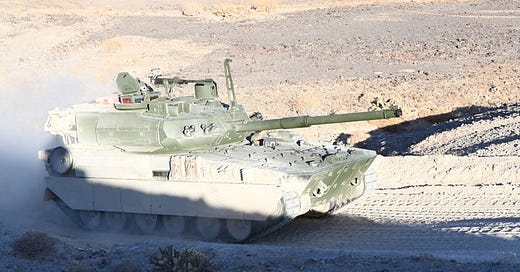The M10 Future Burned-Out Hulk is the Holy Roman Empire of Tanks
The Booker FBOH is neither lethal, protected, nor particularly mobile
The M10 Booker is too heavy for the 101st Airborne to use. When you start to give infantry tanks, give infantry actual tanks.
Huh:
As the 101st Airborne Division prepared last year to receive their first M10 Bookers—armored combat vehicles designed specifically for infantry forces—staff planners realized something: eight of the 11 bridges on Fort Campbell would crack under the weight of the “light tank.”
It turns out that though the vehicle was initially conceptualized as relatively lightweight—airdroppable by C-130—the twists and turns of the Army requirements process had rendered the tank too heavy to roll across the infrastructure at the infantry-centric Kentucky post, and nobody had thought about that until it was too late.
One, the 101st is an air assault division that strikes deep with helicopter mobility. What helicopter could sling-load the M10?
More fundamentally, I’ve long wondered just what the point of this vehicle—once called Mobile Protected Firepower (MPF)—is:
The light tank only survives in a fantasy world of convenient assumptions. In almost all circumstances, American light infantry and airborne forces will go into battle overland. And if what they have to support them is the MPF that is what they will take with them. And they will light up the battlefield as flaming coffins where enemy heavy armor roams.
I dubbed it the Future Burned-Out Hulk, or FBOH for the acronym-addicted out there:
Ah yes, the light tank with a 105mm main gun. And hardly any armor. Which is designed to fight opponents who don't send tanks against those infantry brigades.
Thank God we have enemies cooperative enough to refrain from using main battle tanks against our MPF-supported infantry. Who says Chivalry is dead?
Oh, but the 42-ton tank can be airlifted with the leg infantry!
The times when we will need to rapidly airlift light tanks are rare. And the times that the situation is so bad to require that will not end well for the few light tanks that make it to the front rapidly with American heavy forces weeks or months behind loading on ships in US ports.
And for any sizable light tank force, given shortages of airlift you quickly reach the point where sealift is actually faster. And really, let's see a show of Army hands for those who believe the Air Force will free up the cargo planes and fighter escorts and all the other supporting assets needed to move the light armor in numbers that could make a difference[.]
The Army can call light tanks Mobile Protected Firepower to disguise but not change the reality that they have substandard firepower, aren't protected against anything but the smallest weapon, and aren't mobile strategically in the real world and tactically won't move one bit after blowing up. Really, the MPF is the Holy Roman Empire of armored fighting vehicles.
For the Air Force, there are always more important things than granting Army wishes. Building the Future Burned-Out Hulk won't--and shouldn't--pique the Air Force's interest in moving the vehicle in significant numbers.
As I advocated in Army magazine seven years ago when this tank was a gleam in Army procurement office eyes, if the Army wants light infantry to survive on a deadly conventional battlefield, attach Abrams companies or battalions to those brigades:
If the lightly armored vehicle the Army wants for it IBCTs [NOTE: now called Stryker Brigades] is not going toe to toe with a tank, how does it address the problem that the Army is “increasingly concerned it isn’t prepared for a conventional, high-intensity battle” in a future war, as The War Zone newsletter reported on October 31.
The Army’s enduring dilemma in its search for a light tank that can support infantry is that such a vehicle cannot be lethal, protected and mobile. According to Breaking Defense in October, “The tradeoffs of the so-called iron triangle—mobility, protection, and firepower—have killed or crippled every Army light tank program since 1950, when the M41 Walker Bulldog proved simultaneously too big for airdrops or reconnaissance but too small to fight Russian tanks.”
If the Army wants light, it might get enough firepower, but it sure won’t get sufficient protection.
I was over-optimistic that the Army would at least get light. I should be grateful that the Army didn't think the FBOH would be the wonder tank (in Military Review, starting on p. 28) that combines the lethality and protection of the Abrams with the FBOH ability to cross weaker bridges—but not bridges that the 101st Airborne Division can traverse on its own base.
NOTE: Image is an Army photo from the initial article.




